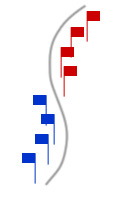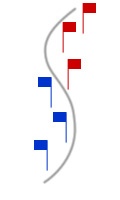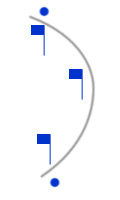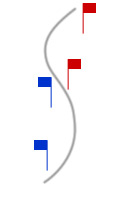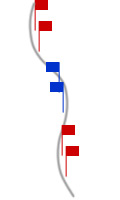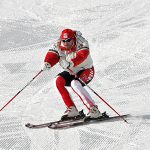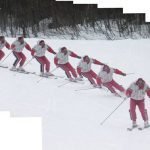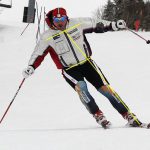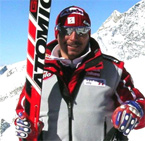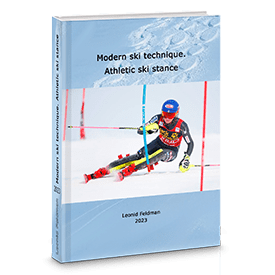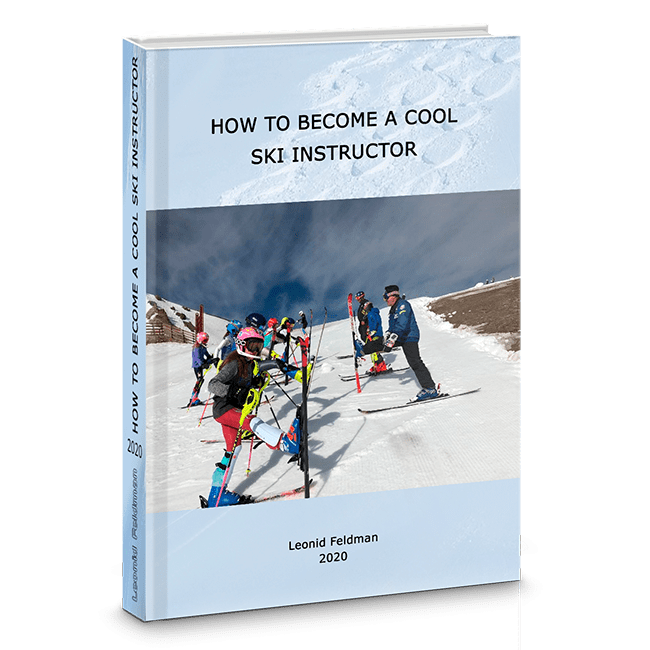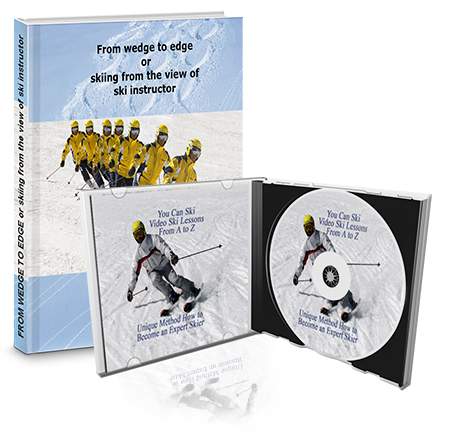Course Inspection/Visualization
In training inspection should be done in exactly the same way it is done before the race. Deliberate and precise inspection should be encouraged at all times. One of the coaches should stand at the gate or combination of gates combination and ask the racers which line he or she would ski.
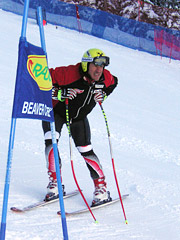
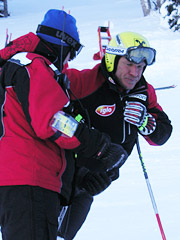
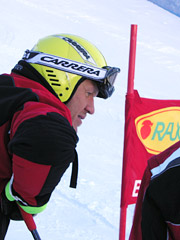
Extra attention should be paid to following two parts:
- Entering into and exiting out of gate combinations.
- Transitions from flat into steep.
During the inspection process nothing should be presented as a problem area (i.e. something scary or difficult). Instead, everything should be viewed positively, in terms of making up time and gaining speed.
Basics of course setting
Progression from easy to intermediate to steep and difficult terrain:
- Set rhythmical course.
- Set rhythmical course with gate-combinations.
- Set various in vertical and offset distances courses well suited for the terrain.
- Set full-length course with all of the above components present.
Remarks on course-setting with change of terrain:
- Speed should be controlled prior to terrain change.
- The next gate after the terrain change should always be visible from above.
- If the gate it set right on the knoll, the turn into the next gate should not have too much of a direction change.
- The fall zone should be taken in consideration.
- Inspect with the racers and teach how to inspect the course in terms of not only looking at the line but also learning how to estimate speed by studying the course.
Common course setting principles for GS
- Set it up taking in the consideration characteristics of the terrain.
- The course should match the level of the athletes.
- Consider weather and slope conditions.
- Safety-measures should be implemented.
Build up progression for GS:
- Start out with easier, more rhythmical run,
- Turns are more in the fall-line
- Turns within some possible terrain undulations
- Course with changes of rhythm,
- Include long turns (blind gates).
Important: always start from basics, move from easier to more difficult.
Slalom Gate Progression
Gate-corridor
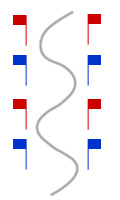 Course setting: rhythmical
Course setting: rhythmical
Aim: Getting used to gates, skiing the right line (pre-determined line). Beginning of basic slalom-technique
Helper-gates: Use colors (like dry-colors on very hard snow/slope) for visual help for starting turns and choosing the line, use foam-pads (donuts) between the knees if skier’s stances are too narrow.
Terrain: easy to intermediate
Gate-to-gate distance: 8m (rather short)
More in the fall-line, about 12-15 gates per section (practice/task), several sections could be used in the progression(but at least two), slight changes from one station to another. Don’t ask for too much.
Vertical and offset gate transitions.
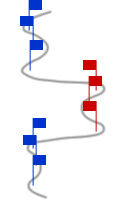 Course setting: rhythmical, 3 gates next to each other, distance about 1-2 m, set course in the fall-line
Course setting: rhythmical, 3 gates next to each other, distance about 1-2 m, set course in the fall-line
Aim: Recognize and adapt to different rhythms
Important :Give a very clear explanation for the task!
This training course could be used to teach gate-clearing with the inside hand and getting used to long gates.
Inside Hand clearing: just long gates, rhythmic, set not too far out of the fall-line, concentration on gate-clearing.
Outside Hand clearing: start with gates leaning to the inside about 60 degrees (depending on the size of a skier), then put the gates straight.
Thin gates with little resistance are more suitable to begin with. If necessary, use turn-helper gates about 40cm (1,5ft) before gate exactly or slightly set off from gate. First ask skiers to ski without touching the gates, in rhythmic run, about 12-15 gates per station.
Transition to Long Poles (Gates):
Run gates without touching and then with touching them. Introduce outside hand gate clearing technique: set long gates not straight but leaning to the inside to be cleared with the outside hand, combine short (stubbies) and long gates. Then set gates straight to be cleared with the inside-hand. Once it is mastered, combine leaning gates and straight gates (OH-and IH clearing). Mix different gate clearing technique, for example: only IH /OH, 4x IH- 4x OH etc.
Vertical gates (gates set in the fall line directly)
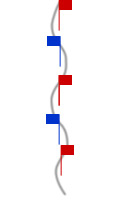 Exercise Goals:
Exercise Goals:
- To reduce fear
- Achieve quick footwork and stabilization
- Encourage to take more risk
- Keeping upper body and arms forward
- Reduce gate-to-gate distance
- Create competition
- Different gate-combinations, change terrain (steep into flat etc.)
Further progressions:
- Rhythmical runs start easy into more difficult
- Set complete slalom courses: Stations (flat/steep) and combination of various stations
End form of both Gate-clean-techniques: (IH / OH)
GS Gate Drills
Methodology:
First set the course using markers, poles, stubbies or other things, several markers per turn
In order to set up proper turn, first let the skiers set the track by skiing in desired turn radii, then set the course using tracks in the snow.
Turn is set with several poles (gates leaning to the inside).
Take down one pole, leaving three poles for each turn only.
Three-pole turn and the entrance marked with stubby
Take away the turn-pole (middle-pole), so two poles are set vertical, focus on turn without turning pole.
Setting Courses in Flat Sections
GS turns in the fall-line, same distance and good rhythmic radius (the goal is to have carve turns in the fall-line and develops feel and touch in ankle area)
GS set a little more out of the fall-line with entry-sign. (stubbies or twigs etc.)
Have racers look at the ski tracks. Then transition to more difficult area. Setting the rhytmical course slightly out of the fall-line. Mark spots for transitions (edge change). Set another rhythmical course, still a little more out of the fall line, keeping the same vertical distance. Then reduce vertical distance. Keep varying rhythm, vertical distances (no combinations, no blind gates). Then proceed to build in terrain changes (use special markings to highlight change in terrain). Start changing the rhythm with gate combinations (blind gates) and change of terrain, keeping the same vertical distance. Finally set normal GS course in its final form with long turns and gate-combinations.
